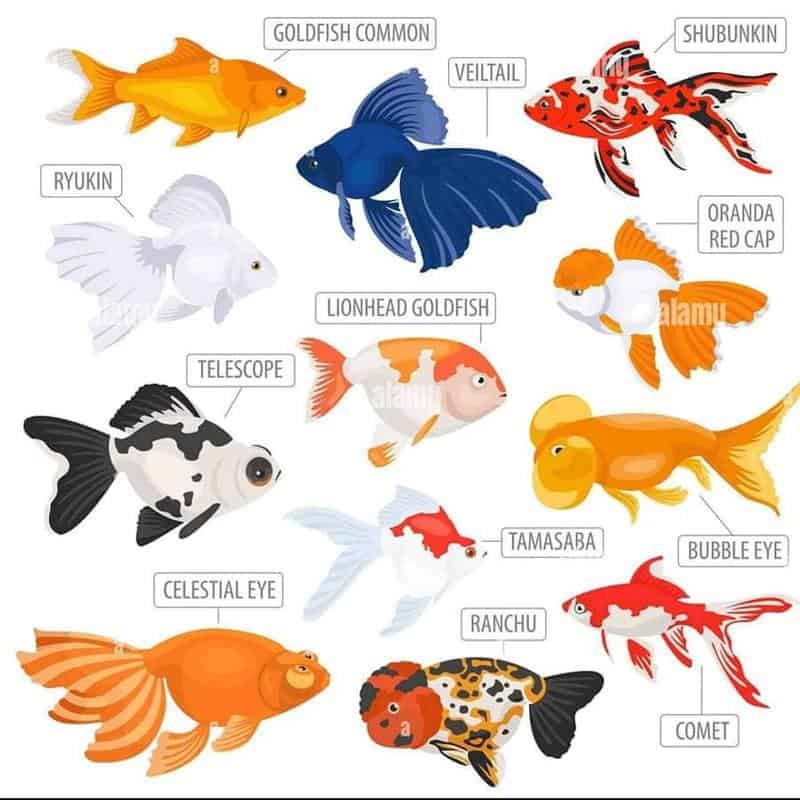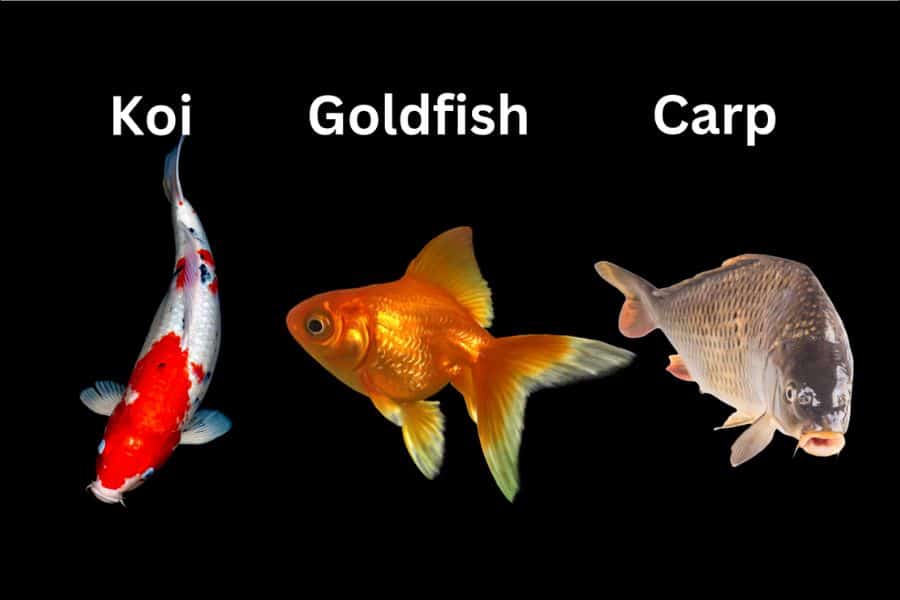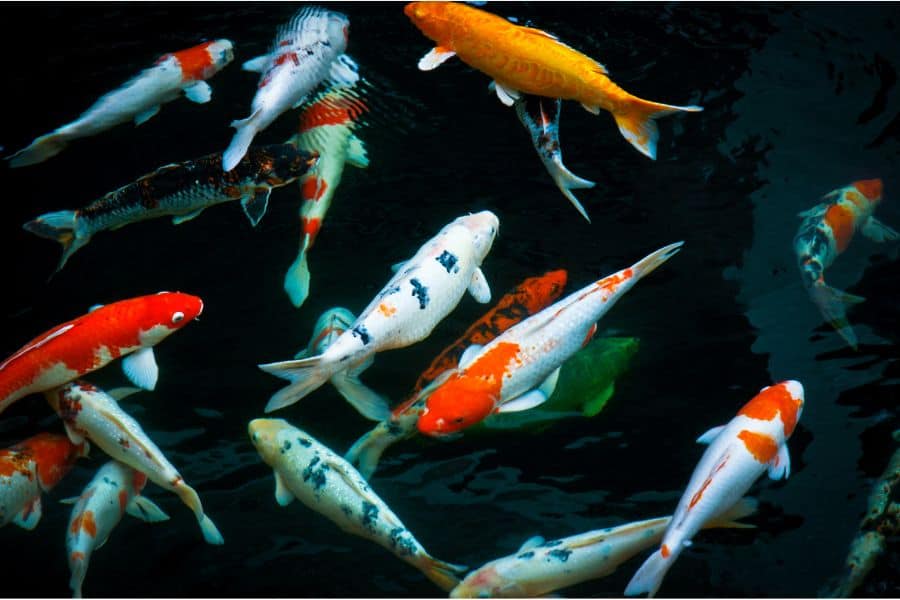Koi and goldfish are the most popular freshwater ornamental fish worldwide. Both fish boast a rich history in Asian culture dating back thousands of years.
But wait, can you tell the difference between koi and goldfish?
Fancy goldfish and koi have remarkably dissimilar features; it is a cinch to tell them apart.
However, slim-bodied goldfish, like Commons, Comets, and particularly Shubunkins, are frequently mistaken for koi.
Some even question if goldfish and koi are carp.
In this article, I will explain the obvious differences between goldfish, koi, and carp. By the end of the article, you’ll be able to identify the two easily.
The next time you’re looking in your pond or at the tank displays in the fish store, you’ll be able to tell which is which.
Where Do Goldfish Come From?

Researchers have proposed several hypotheses to explain the evolutionary origin of goldfish.
Currently, fancy goldfish come in more than 200 different morphologic variations, but they all share a common ancestor.
By analyzing phenotypic traits and physiological and biochemical data, the study concludes that modern goldfish resulted from the distant hybridization of Crucian carp and common carp.
For centuries, East Asians have cultivated many carp varieties for food.
Carp were gray, brown, or silver, but natural genetic mutations produced a smattering of red or gold pigment cells in some specimens.
People then began to breed the colorful varieties selectively in ponds. The goldfish officially became a breed during the Song Dynasty (960–1279).
Countless domestication events have occurred since then. As such, it created a massive variability of ornamental forms.
Where Do Koi Come From?
Most ornamental koi breeds found today are descended from Amur carp, which were aquacultured as food in Japan during the 1820s.
Selective breeding fostered the first generation of colorful Koi varieties.
In 1914, Niigata Koi were displayed at the annual Tokyo expo, bringing them to the forefront of the aquarium hobby. In the subsequent generations, more flashy varieties emerged through cross-breeding.
There are over a hundred varieties of Nishikigoi. In order to simplify the staggering number of Koi varieties, they are divided into 13 classes based on their patterns and colors, with different subtypes depending on those variations.
Fun Fact: The term “koi” is incorrect
While many people know the fish as “Koi,” its actual name is “Nishikigoi.” It was so named since the patterns of the fish were likened to the Japanese kimonos’ multicolored brocade patterns.
“Ggoi” is what the Japanese use to refer to the wild black carp farmed for food. If you look up the word “koi”, you’ll find that it translates to “love.”
Goldfish vs. Carp
Colloquially, heavy-bodied cyprinid fish are collectively called “Asian carp” in the United States, including goldfish.
Some people refer to common goldfish as carp, as they resemble wild carp. Unlike fancy goldfish, common goldfish can grow enormously when released and left to survive in the wild.
But despite their resemblance, common goldfish are not carp.
Goldfish and carp are two different species belonging to the Cyprinidae family.
Goldfish are smaller than carp and have more variation in their tails and fins. Likewise, the color and body types of goldfish are also more varied than those of carp. Carp have not been bred to be tolerant of human interaction, unlike goldfish.
Goldfish vs. Koi
It is sometimes difficult to tell some goldfish varieties apart from Koi when they are young. The common goldfish, Shubunkin, and Comet goldfish have body shapes and coloration similar to Koi. But as they age, the differences become more obvious.
Size
Size is the most dominant difference between goldfish and Koi.
Given optimal care, Shubunkins and Comets, two of the biggest goldfish breeds, can measure up to 18 inches; however, that doesn’t happen often.
Regular Koi, on the other hand, can grow up to 26 inches long in a healthy environment. Meanwhile, jumbo varieties have even surpassed that, measuring upwards of 34 inches long.
Body Shape
Goldfish can be short and egg-shaped or long and streamlined, with slight variations.
All Koi have a thick midsection and a fairly narrow head and tail, giving them a torpedo shape.
Colors, Patterns, and Finnage
Koi have a more diverse and striking range of colors and patterns than goldfish, but their fins are as simple as they come. The Butterfly Koi is an exception, but Koi fanciers do not consider it to be a true Koi.
Goldfish, particularly fancy goldfish, offer more choice in terms of finnage. Some have fantails, veiltails, ribbontails, broadtails, and butterflytails.
Barbels
While there are several ways to tell the two apart, the easiest way is to look for the barbels around the mouths. These whisker-like protrusions are absent in goldfish.
Koi vs. Carp
While the goldfish has been considered a separate species, the Koi is still classified as Cyprinus carpio, also known as the common carp.
In Japanese, the words “ggoi” and “nishikigoi” mean “carp” and “brocaded carp,” respectively.
So yes, the koi, or more specifically, the nishikigoi, is a carp. Nishikigoi are carp that have been domesticated for many decades to bring out certain colors and patterns.
Koi would breed with common carp if left alone in the wild. After only a few generations, their offspring would revert to the standard common carp colors and appearance.
FAQs
Can You Keep Goldfish with Koi?
Common goldfish and large breeds like Comets and Shubunkins can easily live together with koi in ponds. As for fancy goldfish, they are better off in a spacious tank as they are less robust than their slim, elongated counterparts.
Can Goldfish Breed with Koi?
Large goldfish varieties and koi can interbreed. But because they were developed from different species of carp, their offspring are sterile.
Final Thoughts
Despite exhibiting similar colors and behaviors, Nishikigoi, or koi, and goldfish aren’t related, as they descended from different species of carp.
Goldfish resulted from centuries of selective breeding using wild Asian carp, including the Crucian carp.
The goldfish has hybridized so much that it has strayed too far from the original carp blueprint. This is particularly true for fancy goldfish varieties.
Common goldfish may still resemble their wild ancestors, but they are still goldfish when released into the open waters.
Koi, on the other hand, are Amur carp and not a different species. Japanese people call these special Koi Nishikigoi.
But if koi are allowed to breed freely with wild carp, their offspring will revert to their original coloration within just a few generations.

